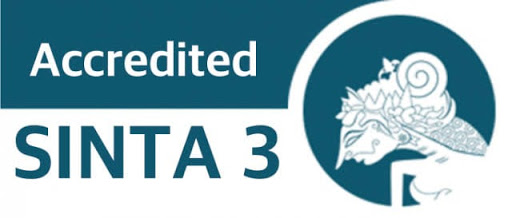CASE BASED LEARNING INNOVATIONS OF ENVIRONMENTAL MANAGEMENT
Abstract
Case Based Learning (CBL) is learning that is oriented towards effective and interesting problem solving, discussions of specific situations and examples of real events in the business world. The object of the case used is an effort to preserve the environment that affects the business world from an economic, social, political and legal perspective. The activity was carried out at Sungai Karang Mumus School (SKM School), which is located on Jalan Muang Ilir, Betapus Village, Samarinda. This study aims to analyze the effect of the application of CBL on the motivation of student learning outcomes. The study used a pre-post-test approach. The total population is 25 students of Master of Management, University of Muhammadiyah East Kalimantan who are members of the environmental management class and use the total sampling technique. Non-parametric statistics, namely the pairing test of the Paired Sample t-test with the Wilcoxon test used in data processing. The results showed that there was a significant difference in student motivation and learning outcomes before applying case-based learning methods and before case-based learning was applied to environmental management courses. Students who are looking to study will have good learning outcomes. Students and then get used to think critically and use prior knowledge in problem solving. This has triggered educators and institutions to apply case-based learning methods as innovative learning.
Keywords
Full Text:
PDF (BAHASA INDONESIA)References
Aliusta, G. O., & Ozer, B. (2016). Theory and Practice Student-Centred Learning (SCL): roles changed? Teachers and Teaching. Teachers and Teaching, 23(4), 422–435.
Bansal, M., & Goyal, M. (2017). To Introduce and Measure the Effectiveness of Case Based Learning in Physiology. International Journal of Research in Medical Sciences, 5(2), 437–445.
Bennett, S. (2010). Investigating Strategies for Using Related Cases to Support Design Problem Solving. Education Technology Research and Development, 58(4), 459–480.
Ciraj, A. M., Vinod, P., & Ramnarayan, K. (2010). Enhancing Active Learning in Microbiology Through Case Based Learning: Experiences From an Indian Medical School. Indian Journal of Pathology and Microbiology, 53(4), 729–734.
Effendi, D., & Multahada, E. (2015). Influence of Intrinsic and Extrinsic Learning Motivation in College Students on Choice of Majors at State Universities. Jurnal Pendidikan Humaniora, 5(1), 15–20.
Gholami, M., Saki, M., Toulabi, T., Moghadam, P. K., Pour, A. H., & Dostizadeh, R. (2016). Iranian Nursing Students’ Experiences of Case-Based Learning: A Qualitative Study. Journal of Professional Nursing, 33(3), 241–249.
Guess, A. K. (2014). A Methodology for Case Teaching: Becoming a Guide on The Side. Journal of Accounting and Finance, 14(6), 113–126.
Ikseon, C., & Kyunghwa, L. (2008). Designing and Implementing a Case-Based Learning Environment for Enhancing Ill-Structured Problem Solving: Classroom Management Problems for Prospective Teachers. Educational Technology Research and Development, 57(1), 99–129.
Kaur, G., Rehncy, J., Kahal, K. S., Singh, J., Sharma, V., Matreja, P. S., & Grewal, H. (2020). Case-Based Learning as an Effective Tool in Teaching Pharmacology to Undergraduate Medical Students in a Large Group Setting. Journal of Medical Education and Curricular Development, 7, 1–6.
Kulak, V., & Newton, G. (2015). An Investigation of the Pedagogical Impact of Using Case-Based Learning in a Undergraduate Biochemistry Course. International Journal of Higher Education, 4(4), 13–24.
Lemos, A. R., Sandars, J. E., Alves, P., & Costa, M. J. (2014). The Evaluation of Student-Centredness of Teaching and Learning: a New Mixed-Methods Approach. International Journal of Medical Education, 5, 157–164.
Majid, A. (2014). Penilian Autentik (Proses dan Hasil Belajar) (Cet. 1). Bandung: Remaja Rosdakarya.
Ngalimun, N. (2014). Strategi dan Model Pembelajaran (Cetakan II). Yogyakarta: Aswaja Pressindo.
Saputra, K. A. K., Priliandani, N. M. I., Pradnyanitasari, P. D., &
Larasdiputra, G. D. (2019). Case Based Learning Dalam Pembelajaran Akuntansi Sektor Publik. Jurnal Riset Akuntansi Aksioma, 18(1), 113–155.
Williams, B. (2005). Case Based Learning—a Review of The Literature: Is there Scope for this Educational Paradigm in Prehospital Education? Emergency Medicine Journal, 22(8), 577–581.
Wospakrik, F., Sundari, S., & Musharyanti, L. (2020). Pengaruh Penerapan Metode Pembelajaran Case Based Learning terhadap Motivasi dan Hasil Belajar Mahasiswa. Journal Health of Studies, 4(1), 30–37.
DOI: http://dx.doi.org/10.33578/pjr.v6i6.8932
Refbacks
- There are currently no refbacks.
Copyright (c) 2022 JURNAL PAJAR (Pendidikan dan Pengajaran)

This work is licensed under a Creative Commons Attribution-NonCommercial-ShareAlike 4.0 International License.
JURNAL PAJAR (Pendidikan dan Pengajaran)
Secretariat
Program Studi Pendidikan Guru Sekolah Dasar
Gedung B1, FKIP Universitas Riau
Kampus Bina Widya Km. 12,5 Simpang Baru Panam
Pekanbaru Riau Indonesia 28293
e-mail : pajar@ejournal.unri.ac.id




